Every day I checked the weather, usually more than once, and every day, it changed — sometimes it changed multiple times per day! It was still three days until my trip would start and I couldn’t keep up with the changing forecasts.
Two weeks ago, my husband, dog and I backpacked in the Stanislaus National Forest. It was warm and gorgeous. But now, the weather was calling for cold temps and potentially rain and/or snow.
This was problematic in that I was taking a group of women from my Meetup.com group backpacking for two days and one night and it had been planned for weeks now. I had seven other women coming with me – the trip had to happen!
I emailed the women and let them know what the weather conditions would be like. I asked them to be sure their sleeping bag and pad were rated to handle freezing or near-freezing temperatures, and to remind them to bring rain gear. Almost immediately, one woman changed their RSVP to “no”. Perfect. I don’t want people coming who don’t have the proper equipment or who wouldn’t be comfortable. That would be bad for everyone.
The next day, another woman dropped out. She had called the ranger station and was told the route I had planned was impossible due to massive amounts of snow, frozen lakes and blocked roads.
I knew this was a bunch of B.S. given that we had heard the same misinformation from rangers two weeks earlier and had actually come across almost no snow below 8,000 ft. and no frozen lakes anywhere.
Besides, I always have a Plan B for situations like this: hike in a different area! Specifically, if we really couldn’t go the route I wanted to go, we would just switch over to the same route I took two weeks ago.
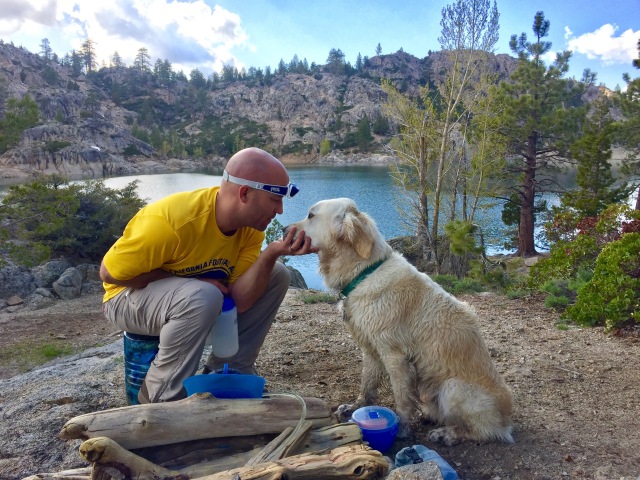
I sent another email out to the women letting them know rangers frequently had outdated or erroneous information and, surprisingly, could not always be trusted to have the latest info. I let them know I had a Plan B (and C and D) in any case, and asked them to simply be flexible and adaptable. Adaptability is pretty much a requirement for backpacking.
Four of us arrived at the Pinecrest Lake campground on Friday afternoon. We had agreed to share a car camping site so we could be ready to go, nice and early, Saturday morning. The other two women, incidentally, were no-shows. Such is often the case with any Meetup.com group.
On Saturday morning, we learned that one member of our group was too cold overnight. Knowing it would be even colder on the trail, she was ready to call it quits and go home. But, instead, we convinced her to stay by having her share my tent for extra warmth and adding a warm water bottle to her sleeping bag before she got in. Problem solved (we hoped).
The four of us marched into the ranger station and told the ranger we wanted our trip to start at the Crabtree Trailhead. We were given the same info: the roads are snowed in, the trail is covered in snow and the lakes are frozen (spoiler alert, most of their info was wrong).
Armed with the info I had from backpacking in the area two weeks previously, I politely and respectfully let the ranger know I thought he had outdated info.
He was not swayed but let us know we could certainly give it a try, and he would be appreciative of updated info about the conditions out there when we were done. The only hitch: the road was actually gated about 2.5 miles from the trailhead.
We four ladies had a quick chat. We all agreed we preferred to have a bit of an unknown adventure rather than go to the same trailhead I had just been to two weeks earlier. LOVE these ladies! Everyone was willing to be flexible and adaptable.
We set off and parked on the side of the road where it was gated. A new problem popped up — one of the women’s water bladder seemed to have a small leak and had soaked the bottom of her pack. We ditched her bladder and she brought a 2-liter water bottle instead. Problem solved.
We hiked the 2.5 miles on clear pavement to the eerily empty trailhead parking lot and campground. The road had no downed trees, only tiny patches of snow and no other obstacles. Could have been opened for vehicles probably weeks earlier.

We hit the trail and found it clear but certainly damaged from the brutal winter storms California had suffered in the very recent past. There were a few downed trees across the trail here and there, and areas where unexpected streams had wiped out small sections. But nothing was difficult to get around. Water was everywhere! Not only were the creeks flowing crazy fast, but the seasonal streams were roaring and there were countless streams and waterfalls in places where there shouldn’t have been. It was beautiful and nothing was too difficult to get across. Plus, snow was basically non-existent.
For sure, it was COLD! Not miserably so, but just just cold enough to make layering problematic. We would wear extra layers, but then the sun would decide to come out and we would quickly overheat. We would remove layers, but then the sun would disappear or the biting wind would pick up. Layers back on. The going was sometimes fast, sometimes slow as we found safe ways across crazy creeks or made our way around fallen trees. Every one of us was a trooper and we enjoyed the remote feeling of it all — as if we were exploring uncharted areas.
We made it to Camp Lake, which we had been told was frozen solid. Nope. Wrong again. The lake was completely thawed and there was very little snow anywhere. Just water. Water everywhere! We found a dry campsite on the cliffs overlooking the lake and setup camp.
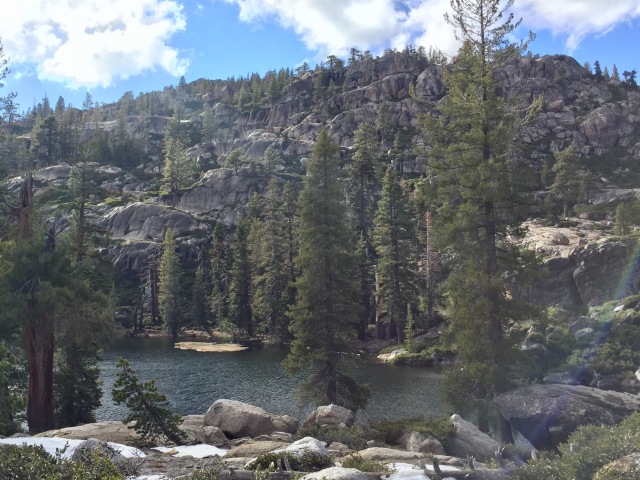
Being still early in the afternoon, three of us decided to ditch our heavy packs and do an out-and-back hike to Bear Lake — another 1.5 miles past Camp Lake. The fourth woman decided to take advantage of the early quitting time and take a luxurious nap — smart woman!
The three of us set out and quickly started running into much larger patches of snow ranging from just a few inches deep and a few feet in length to depths of five feet spanning a few dozen feet. The snow was hard packed and slippery, which made staying on the trail impossible at times. But some other hikers had been out there and there were footprints to follow much of the time.
More problematic than the snow was the water. The creek had completely swollen over its banks and had essentially flooded out the entire valley we hiked through. The meadows were covered in water trying to flow to a legit stream or creek. There were waterfalls coming off the cliffs into the valley, not into any kind of water way. Tiny, unmapped ponds sometimes swallowed up our trail.
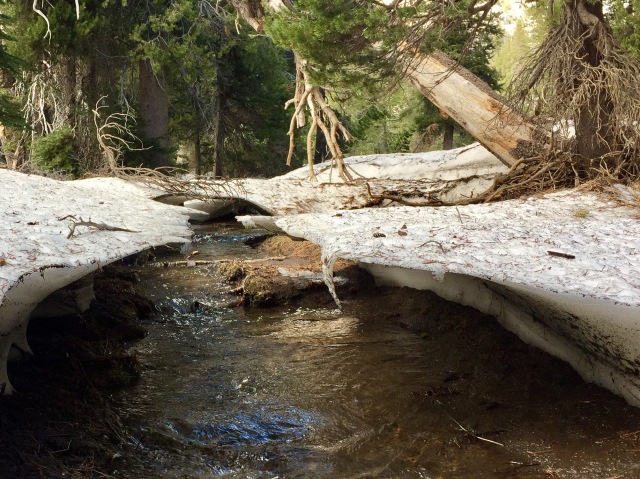
In many places, the water had smartly found the path of least resistance – our trail. At times, the trail was under three feet of water and it was difficult to tell what was trail and what was a seasonal stream criss-crossing our trail. On more than one occasion, we had to use GPS to figure out where we were in relation to the trail. But, eventually, we made it. It was all very doable and not too difficult.
Bear Lake was frozen! The rangers got one thing right. The edges were clear of ice, but the majority of the lake was still solid. For the life of us, we couldn’t figure out why. We had only gone up maybe two-hundred feet in elevation since Camp Lake. Bear Lake had full exposure to the sun for most of the day. Why was it still so frozen when Camp Lake, roughly the same size and less exposed, was fully melted?
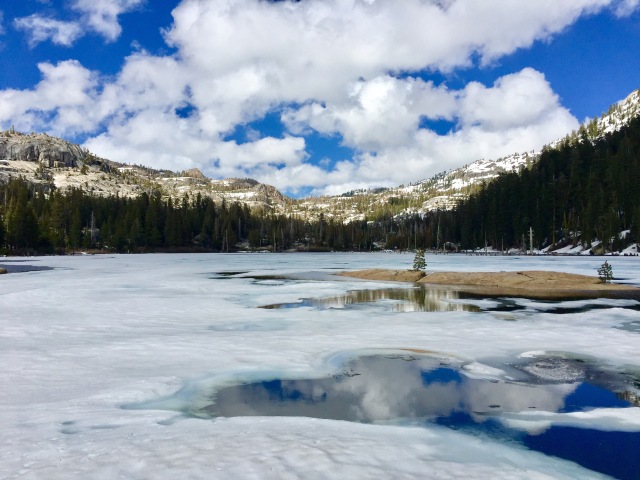
We enjoyed the stark beauty and the contrast between the lush greens of spring and the bright whites of winter. After some time, we trudged back to Camp Lake, getting temporarily “lost” and breaking out the GPS more often than I care to admit. That three mile out-and-back, sans packs, was more taxing than the six miles we had done to get to Camp Lake!
Back at our campsite, we cooked our dinners, made a fire (which was difficult since most everything was damp) and relaxed before bed. As night fell, the temps dropped significantly. For two of us, bedtime came early just to escape the cold!
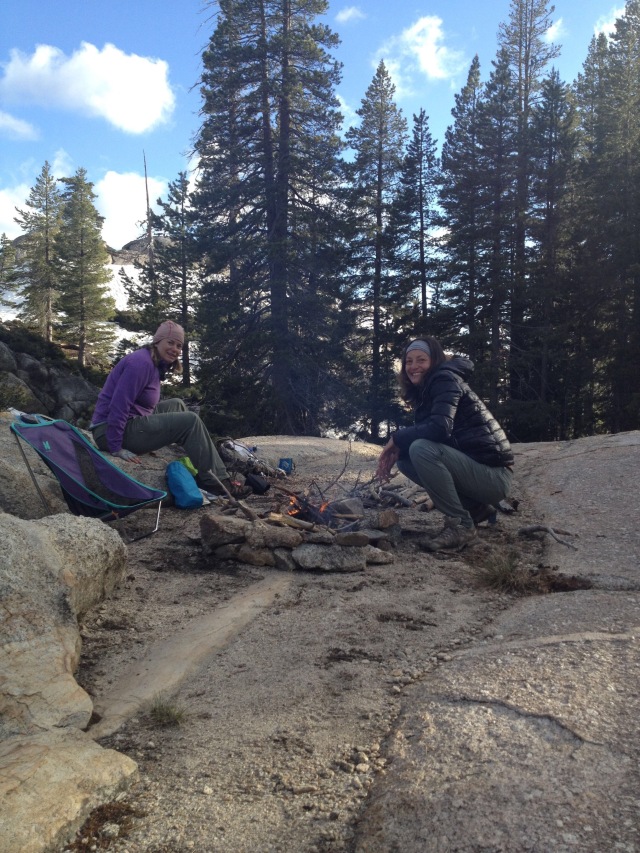
When I went to change into my wool base layer (my PJs), I found that I had made an egregious mistake. Back at the Pinecrest Lake car camping campground, I had two identical, orange ditty sacks — one held my car camping clothes from the overnight at Pinecrest Lake and the other held my base layers, gloves, warm hat and sleeping socks for backpacking. Apparently, I had put the wrong ditty sack in my backpack and left the correct one in the car back at the trailhead!
Time for another Plan B. For my torso, I slept in my t-shirt, fleece pullover and down puffy jacket. For my legs, all I had were my thin hiking pants, so I added my rain pants. Lord knows rain gear NEVER breathes as well as the manufactures would have you believe. Wearing rain gear when cold is a classic trick to beat the freezing temps. I felt stuffed into my sleeping bag, but I was warm and cozy as the temps plummeted.
We woke up to dark, ominous looking skies and below freezing temps. We all quickly agreed to forgo making breakfast in favor of packing up and heading out; we were too cold to sit still and eat!

As we were packing, the hail started. All we could do was be thankful it wasn’t rain and enjoy the special beauty it brought the forest. The bright greens of the mosses and grasses were accentuated by the fog and lack of sun. The tree tops were shrouded in a dense and drifting fog. The hail tapped the ground, sounding more like rain on a tin roof. It was cold and our plans were changing again, but we were energized by the unique beauty and feeling of adventure.
Our hike back to the cars was fast and it hailed on-and-off (but mostly on) for 2.5 hours. I ripped my Frogg Togg rain gear climbing through downed trees and scooting my way across a river on a wet, slippery fallen tree, but we four ladies loved every moment of it (for the most part).
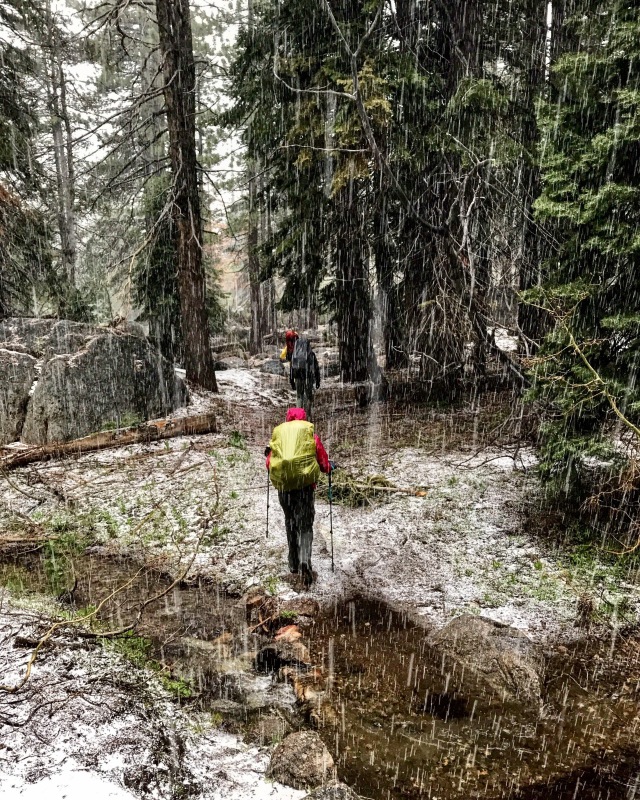
Back at the cars, we changed into warm, dry clothes and shoes and got the car heaters going full blast. A stop for burgers at a pub finished off the trip perfectly.
I don’t mean to imply that park rangers aren’t trustworthy – you should probably always listen to them. But my experience two weeks earlier let me know they don’t always have the correct info. On this trip, they got one thing right: Bear Lake was frozen! But we had alternate plans and a group of people willing to go with the flow. Adaptability is the name of the game here.
You can, and should, plan your trips out as best you can. But you must always be willing to be flexible. Missing a piece of equipment? Improvise. Need extra clothes? Wear everything you’ve got! Worried about the trail conditions? Have a GPS app ready on your phone and know how to use a map and compass.
Don’t be rigid. Don’t count on everything going according to plan. In fact, it most likely won’t, and that’s OK! It’s not a real adventure if everything goes perfectly and nothing unexpected ever happens.
“Wherever you go, no matter what the weather, always bring your own sunshine.“ – Anthony J. D’Angelo
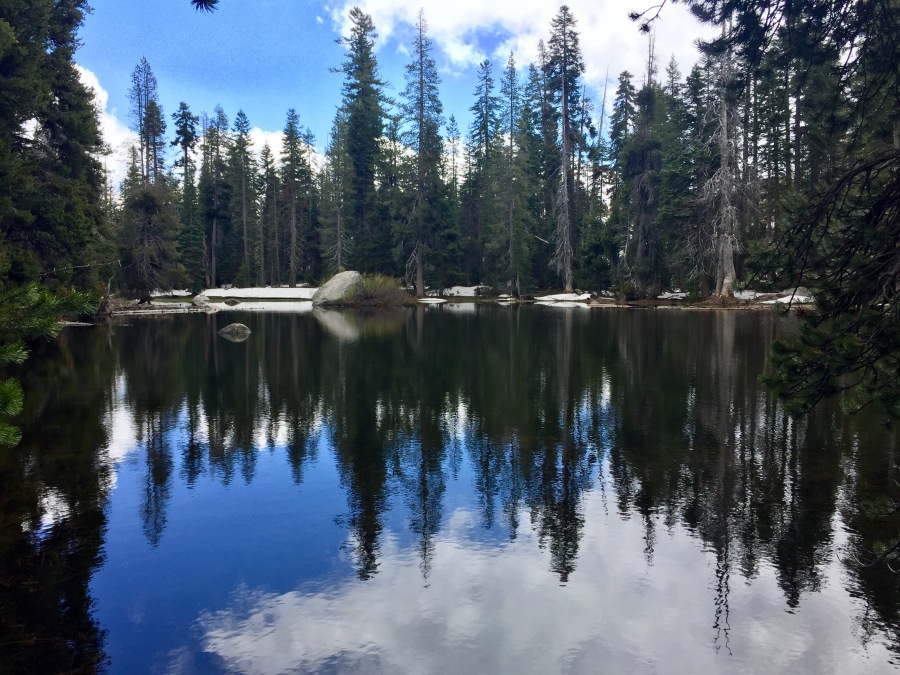
Hi Liz, This was a really good read! Looking forward to the next one!! XO Aunt Kim
Sent from my iPad
>
LikeLiked by 1 person
Thanks, Aunt Kim! 😘
LikeLike